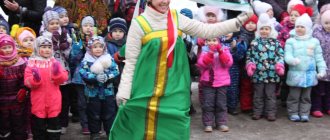Holiday - time off from work
Vacation is often called a holiday. Therefore, it is important to note, from what word does the word “holiday” come from? The word “holiday” is associated with the word “idleness,” and idleness in Rus' was considered time free from work. In ancient times, most of our ancestors were farmers, that is, they worked on the land. And work on earth is very hard. So, the Russian people and their ancestors, the ancient Slavs, always knew how to work hard, but they also knew how to cheerfully celebrate days free from work.
All holidays that were celebrated in Rus', in Russia previously and are celebrated now, can be divided into three main groups:
- civil (state)
- folk (holidays of the national economic calendar and personal ritual holidays)
- church (religious)
Caroling
This is a holiday of Christmas songs and carols, which takes place on the morning of January 7 or from the evening of January 6 after the rising of the first star.
Kolyada
According to legend, the ritual promised the owners of the house a good harvest in the garden, in the field, a large offspring of livestock and general well-being.
Therefore, carolers always tried to go around as many houses as possible, except those where someone had recently died. According to tradition, they usually started from west to east in the village and from the bottom up in the mountains.
The ceremony takes place in three stages:
- Initial preparatory – rehearsals, rehearsals, searching and trying on costumes.
- The main carol round is the gathering of participants in one place, a procession through the village, contact with the owners, and receiving delicious gifts.
- The final one is a joint meal of carolers at the end of the ritual.
In Rus' it was believed that carol walks exorcised evil spirits and protected from disease. In ritual sentences they were called God's messengers or unprecedented guests.
Russian civil (state) holidays
Civil holidays reflect the connection between a person and the state, so they can also be called state holidays. In addition, they are established by the state. The most important of these at present are the following days:
- Defender of the Fatherland (23.02)
- International Women's Day (8.03)
- Spring and Labor (1.05)
- Victory (9.05)
- Russia (12.06)
- National Unity (4.11)
- Constitution (12.12).
Most public holidays are associated with various significant events in the history of the country and state, and they are marked with a red day on the calendar. But there are many holidays that are not widespread and are celebrated on weekdays or dedicated to a weekend and celebrated on one of the Sundays. They are a type of civil holiday and are associated with various areas of public life. For example, such holidays as Knowledge Day (1.09), Teacher's Day (5.10), Day of Slavic Literature (24.05), Children's Day (1.06), Victory Day are associated with the educational sphere.
There are military holidays: Navy Day (last Sunday in July), Border Guard Day (May 28), Artillery and Missile Forces Day (November 16), Airborne Forces Day (August 2). There are many professional holidays: Fisherman's Day (second Sunday in July), Medical Worker's Day (third Sunday in June), Cultural Worker's Day (March 25), etc.
Maslenitsa
One of the most popular, well-known ancient holidays, which was associated among the pagans with the remembrance of their ancestors. Hence the eating of pancakes - funeral food. Also, the holiday symbolized the arrival of spring, pagan rituals were performed.
On Maslenitsa, it is customary to burn a straw effigy, personifying winter.
Symbols of Maslenitsa
Over time, the sad holiday turned into a day of fun and joy. Horse-drawn sled rides, fist fights, and mother-in-law get-togethers were added to the traditions of burning effigy and cooking pancakes.
Holiday entertainment
Maslenitsa rituals are interesting and unusual. They combine the end of the winter holidays and the beginning of spring. Maslenitsa is celebrated 7 days before the start of Lent. Farewell to her takes place on Sunday.
Russian holidays - folk
Russian folk holidays arose in the culture of the people in ancient times, therefore they have long traditions and are divided into holidays of the national economic calendar, reflecting the connection between man and nature, and personal ritual holidays associated with various events in people’s lives (birth, wedding, funeral, etc.) .d.).
Folk dances
Folk holidays have the deepest cultural and historical roots and, first of all, are associated with the agricultural calendar, to which the life of people in traditional society was closely tied during one of the longest periods of human existence. Our Slavic ancestors at that time were pagans, so most of these holidays are of a pagan nature. Among the most famous folk holidays we can note such holidays as Maslenitsa, Carols, Kuzminki (Kurya name day), and the holiday of Ivan Kupala.
Why were rituals needed?
Christmas, the rite of Epiphany, Easter are traditional Christian holidays, and Maslenitsa and Ivan Kupala are rooted in paganism.
Pancakes and Maslenitsa symbols
Rituals
Since the times of Slavic antiquity, many legends have been preserved in everyday signs that are associated with the birth of a child, holidays, and the burial of the dead.
Customs
The Russian people adhere to many customs, believe in omens and are generally very superstitious. Some of them:
- It is not customary to say hello, say goodbye, or pass something across the threshold to each other. This is because the brownie rules the house and makes sure that there is order everywhere. And beyond the threshold is the territory of alien forces that can cause a quarrel and interfere with friendly wishes.
- It is customary to bring a cat into the house for a housewarming party. By her behavior they judged what life would be like in her new home. Among the Slavs, this animal is considered dedicated to the brownie; the cat personifies the owner of the house.
Many people still nail a horseshoe over the door of their house “for good luck,” not knowing that by this action they are transferring the house under the protection of Dazhbog the Sun with his cavalry. The horses of the pagan god were supposed to bring good luck to the household.
Church, religious Russian holidays and traditions
Church or religious holidays and traditions reflect the connection of the people with God and appeared in Rus' after the adoption of Orthodox Christianity in 988, in connection with its spread and establishment. Having replaced pagan beliefs, monotheistic religion contributed to the spiritual unity of society. It was Christianity, as a monotheistic religion, that then contributed to the construction of a unified Russian state.
Some of the most significant Orthodox holidays are Easter, Christmas (7.01), Annunciation (7.04), Trinity, Transfiguration of the Lord (19.08), Dormition of the Virgin Mary (21.09). Some holidays are tied to certain days, others are counted from Easter, which is calculated according to the lunar calendar and taking into account the vernal equinox, namely, it is celebrated on the 1st Sunday after the 1st full moon, which, in turn, occurs after the vernal equinox .
Among the church holidays, the most important are the twelfth holidays - these are days especially revered in Christianity. These include:
- Nativity of the Virgin Mary (21.09)
- Exaltation of the Holy Cross (27.09)
- Introduction to the Temple of the Blessed Virgin Mary (4.12)
- Christmas (7.01)
- Epiphany, or Epiphany (19.01)
- Presentation of the Lord (15.02)
- Annunciation of the Blessed Virgin Mary (7.04)
- Entry of the Lord into Jerusalem (Palm Sunday) (last Sunday before Easter)
- Ascension of the Lord (Thursday - 40th day from Easter)
- Trinity Day (Sunday on the 50th day from Easter)
- Transfiguration of the Lord (19.08)
- Dormition of the Blessed Virgin Mary (28.08)
Particularly revered holidays in Rus' were the Intercession of the Blessed Virgin Mary (10.14), the Day of the Kazan Mother of God (11.4), the Honey Savior - the 1st day of the Dormition Fast, the Nativity of John the Baptist (7.07), and a number of others.
It should be noted that every day of the church calendar several saints are honored. For example, on November 14, the Day of the unmercenary saints Cosmas and Damian, healers and miracle workers (the national holiday of Kuzminki is named after them), the martyr Adrian, the holy martyrs Jacob, Alexander, the Monk David and other lesser-known saints is celebrated; and on November 26, the day of remembrance of John Chrysostom is celebrated (celebrated), a man who lived in the 5th century A.D., was distinguished by his special eloquence and defended the faith in Christ from the pagans. On the same day the memory of the martyr Herman of Caesarea is honored. And so every day. In honor of the saints, names were given to newborns born on the day of their honor.
Sergius of Radonezh
Nicholas the Wonderworker
The most revered of the saints in Rus' was Nicholas the Wonderworker. And since in the Orthodox calendar there are two days dedicated to him, in Rus' they celebrated St. Nicholas of the Winter (12/19 - the day of the death of the saint) and St. Nicholas of the Spring (or Summer) (22.05 - the day of the transfer of his relics). The apostles Peter and Paul were widely revered, their holiday, which ended Peter's Fast (July 12). Among Russian saints, Sergius of Radonezh and his memorial day (July 18) were especially revered.
Yuletide rituals
At the beginning of the year, the Slavs traditionally celebrated pagan Christmastide. The Christian holiday - Christmas - merged with these celebrations.
On Christmastide, people wore carnival costumes, masks, and animal skins in order to deceive evil spirits.
These creatures, according to legend, come “to this world” on holidays and become unusually strong. To ward off evil spirits, the Slavs had fun, made noise, celebrated, sang songs and had fun in every possible way.
Fun for Christmastide
At Christmas time, it was customary to tell fortunes about the offspring of livestock and the future harvest. And young girls were waiting for this holiday to tell fortunes about their future marriage. There were dozens of methods of fortune telling. One of them is “snow weeding.”
At night, the girls went outside the gates of their house, stood facing the wind and threw snow against it. If he fell with a loud sound, this foreshadowed his imminent marriage to a young man. When the opposite happened, the snow fell dully and crookedly - the groom was destined to be old and deaf.
Maiden fortune telling
It was also customary to perform rituals and magical rites that should ensure fertility. The boys picked up mittens full of grain and went from house to house, “sowing” it. At the same time, they sang songs that glorified the owners. The children were given sweets and pies.
Christmas festivities
Pagan Christmastide is similar to Orthodox Christmas. The rituals and traditions of the Russian people are intertwined.
New Year - three Russian traditions
Nowadays the most beloved holiday by the people is the New Year. And it was also not always celebrated as it is today, and this is due to some features and changes in the Russian calendar. We can say that this holiday appeared as a folk holiday, then began to be celebrated as a church holiday, and then became a public holiday and a red day of the calendar.
Since the pagan farmers were guided by the annual cycle, their year began when nature woke up after hibernation, that is, in the spring. The year waned in autumn and winter, when everything around withered and froze. Long after the adoption of Christianity, the New Year in Rus' was celebrated on March 1, that is, from the beginning of spring and the awakening of nature (until 1348). It was a pagan folk calendar.
In the period from 1349 to 1699, the beginning of the new year began to be celebrated on September 1, guided by the church annual circle, where the church calendar began on September 8 (09/21 according to the new style) with the celebration of the first twelfth holiday - the Nativity of the Virgin Mary. In the church, the new year is called the New Year.
On January 1, 1700, by decree of the Tsar-Transformer Peter I, the New Year began to be celebrated according to the Western model, as in Europe. This is how the civil calendar began to operate in Russia. But in those days the old style (Julian chronology) was still in effect, according to which the Orthodox Church still lives. And the new style (Gregorian calendar) began to operate in 1918, that is, after the revolution. There are 13 days between the old and new style dates. Therefore, from that time on, a tradition arose in Russia to celebrate a holiday that was amazing for foreigners - the Old New Year.
Very often, church, folk and state holidays are somehow intertwined, as happened with the New Year, they can be connected to each other by both external and internal invisible connections, and coincide. Why this happens and whether there is any logic to it, we will tell you in other publications in this series.
How useful is the publication?
Click on a star to rate!
Average rating 5 / 5. Number of ratings: 3
No ratings yet. Be the first to rate.
Weddings of peoples living in Russia
Weddings of the Russian North, due to the sad nature of the rituals, expressed in the lamentations of women, the heart-tugging rituals of the bride’s transition to a new status, in other words, are called a wedding-funeral, and for the southern regions of European Russia and the West, a more festive mood is characteristic, a loaf ritual with loaf songs, a wedding is called wedding-fun, interesting rituals with a wedding tree-beauty. Elements of magic in some regional traditions have survived to this day; pre-Christian origins are clearly felt in them. The transition of a girl to her husband’s clan from her father’s clan is the main symbolism of such rituals. Paganistically, this entailed the patronage of male spirits. This is akin to death in one family and birth in another, which is why it is customary to lament and howl for a bride, as if for a dead person. Going to the bathhouse at a bachelorette party is also symbolic of washing the dead. And it was customary to lead the bride to church by the arms, thereby symbolizing lifelessness. lack of strength. In order to deceive the brownie, it was customary for the groom to carry the bride into the house in his arms, thereby forcing him to accept the girl as a newborn family member. Nowadays, especially in multi-storey buildings, it is quite difficult to repeat this.
Rituals when receiving guests
The Russian people are very hospitable - hospitality has always been the main distinguishing feature of the Slavs. It demonstrated the greatness of the human soul and material generosity. The hospitable host was ready to give the best piece to the guest and share everything he had with him.
Important! To receive, feed, put to bed, give something for the journey - such a manifestation of hospitality was natural for a Russian person.
“Bread and salt” are symbols of abundance and prosperity.
In every home they welcomed the guest, greeted him with bread, salt, a hot lunch, pleasant conversation, and surrounded him with care.
Saved
Savior - on behalf of the Savior, Jesus Christ. Since ancient times, Orthodox Christians have celebrated the Three Saviors per year:
- August 14 - Honey Spas.
- August 19 – Apple Spas.
- August 29 – Bread or Nut Spas.
Each of them has its own symbol: honey, apples, bread. They said about this day:
“The first Savior stands on the water, the second Savior eats apples, the third Savior sells canvases on the green mountains.”
People explain the name of the holiday in their own way - in the best traditions of harvesting: “to save themselves” by storing the harvest for the long winter.
Tea party
If, what is a song without a button accordion, then what is a bathhouse without subsequent tea drinking. Our ancestors enjoyed a similar ritual both on long winter evenings and short summer evenings. True, there were only two types of tea - yellow and green. The leaves of the drink came from distant China, and tea lovers did not sweeten it with sugar.
Perhaps that is why at first women did not drink it at all. After sbiten and honey drinks, the tea seemed tart and bitter. However, by the mid-19th century, in Moscow alone there were several hundred specialized shops selling various types of tea.
Funeral rites
The Slavs believed that by moving into the world of the dead, the deceased opens the door to the other world, and from there evil spirits can come. Therefore, Slavic funeral rites were aimed at protecting the living:
- women covered their heads with a scarf and wore amulets;
- things that could be useful to the deceased in the next world were placed in the grave;
- a clean towel was hung on the window;
- Pancakes and a glass of alcohol were left on the grave.
These and other customs are still found among the Slavs. In order not to forget Russian rituals, they are revived in folklore festivals. People remember legends, find old-timers who keep the secrets of the past. They decipher the meaning of ancient amulets, celebrate ancient holidays, and tell children about the traditions and culture of their people.
Ivan Kupala
For the girls it was a real holiday - an opportunity to show themselves in all their natural beauty. They wove wreaths from flowers, led noisy round dances around the fire, and sang songs. Often, a high pole with a burning wheel, symbolizing the daylight, was installed in the center of the round dance. The songs characterized Kupala as loving and cheerful.
As the Sun set over the horizon, the girls lowered the wreaths into the river and watched their progress. If the wreath has been afloat for a long time, it means that the girl is still desirable to the beloved, and one can hope for a quick wedding. If the flower wreath sank, you could no longer count on your friend’s love.
The witches collected medicinal herbs at night, which had the most healing power that night. The blossoming fern flower, according to legend, showed the lucky one the location of all the treasures hidden in the ground. But simply seeing an open fiery red flower also promised good luck - the fulfillment of all innermost desires. There was also no sleep that night. The evil spirits that came to earth could easily bewitch a sleeping person and cause him harm.
12 rituals for love at Epiphany
Easter
The Holy Resurrection of Christ came to us from Byzantium. The Kiev prince Vladimir and his squad settled on the faith they had chosen and ordered the baptism of all residents of Rus' and large cities at that time - Kyiv and Novgorod.
On the eve of Easter, all Orthodox churches hold all-night vigils, ending with a procession of the cross around the church. When morning comes, the rest of the population flocks to the courtyard, bringing with them holiday cakes - Easter cakes and colored eggs.
After their consecration, believers go to their friends and relatives to give dyes and Easter cakes. Instead of the usual greeting, a festive greeting is pronounced: “Christ is risen!” It flies back to them, “He is truly risen!” Almost all greetings are accompanied by hugs and kisses - the birth of Christ
The Christian holiday is the first day after Lent when you can eat fatty foods. Therefore, Easter dishes have always been distinguished by their variety and taste. However, holiday cake and eggs are always the main decoration of the table. Eggs were traditionally colored in various shades of red, but later the color scheme began to resemble a rainbow.
Paska was always baked from yeast dough, which allowed it to become tall and round. The top of the Easter cake is always crowned with an image of a cross. Following the signs, beautifully baked goods symbolize well-being in the family.
Note! Easter cake for eating is cut only crosswise in order to keep the top intact for later covering the remaining cake.











